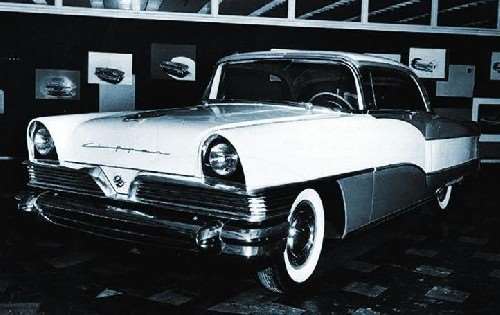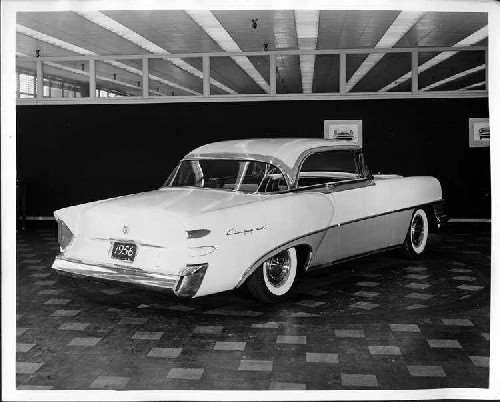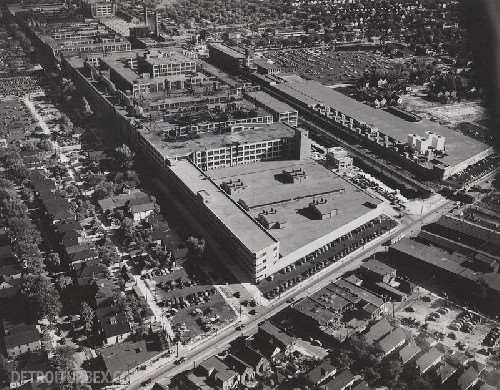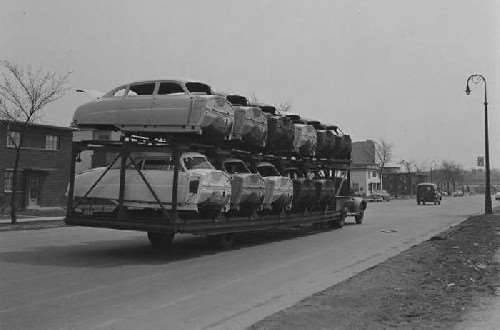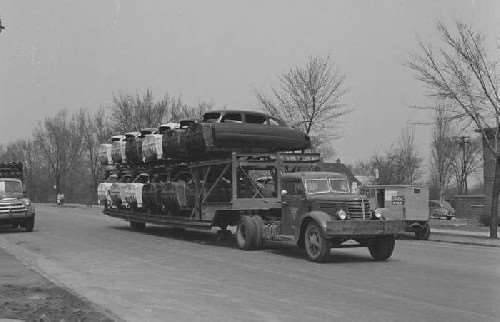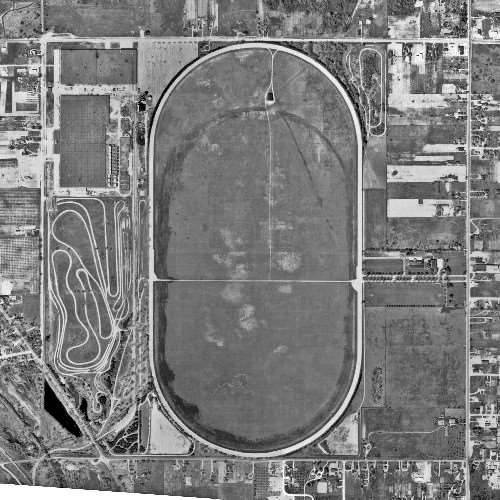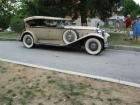|
Re: New "What Ifs?"
|
||||
|---|---|---|---|---|
|
Home away from home

|
Introducing the 1955 Hudson Hornet:
So how close were the Clipper and Hornet? The Hornet's wheelbase was 2" longer, but the Clipper was 5-6" longer overall. They both weighed 3600 lbs and sold for virtually the same price. Ideally, they would have merged in early 53, so the first diverging Clipper styling elements, the "sore thumb" taillights and the 54 insurment panel, could be diverted to the Hudson, so only distinct grill and bodyside trim would need to be developed for the MY 54 Hudson. I had an opportunity to measure the length of a Packard 359 in a 54 convertible that was on the 122" wheelbase at a show a week ago. The head was about 32 1/2" long. I had previously measured a 308 at the Hudson museum in Ypsilanti: 30". So adapt the 308 to the Packard transmissions and it drops right in, and, the weight of the Clipper being the same, should provide performance equal to the step down Hornet. The Wasp was built on a shortened Hornet platform, but, as Wasp sales were about half that of the Hornet, I would question the investment in shortening the Clipper platform. Just offer the Wasp as the low trim option, with the Hornet being the high trim option, and offer the "twin H power" engine option. Meanwhile, the Clipper would be positioned as a short wheelbase Packard, as the Executive was, rather than as a cheaper car, the lower price point being filled by the Hudson. All the Packard body tooling would be moved from Briggs to the larger Hudson body plant. Nance had been looking for a way to get free of Briggs but the capital cost to buy new equipment was prohibitive. By merging with Hudson in a stock swap, Packard would obtain a body plant, fully equipped and staffed, for free. The Hudson body plant is even a bit closer to EGB: on Conner between Harper and Gratiot. If the sales numbers are right on classiccardatabase, in 55-56, when Hornet customers had a choice of the 308 or Packard V8, the take rate for the 308 was 10% higher than the V8, so that engine had it's own following among Hudson customers. Phaseout of the 308 would need to be managed carefully. For 55, I would keep Torsion-level as a Packard exclusive, but I would want the superior dive/squat performance of the trailing arm rear suspension for the Hudson, so I would adopt the rear suspension for progressive rate coils. Under the hood, I would keep the 308 as the base engine for both Hornet and Wasp, but offer the low compression 320 that was sold to Nash as an option for the Hornet. Should I decide to retrim the shortwheelbase 54 Packard convertible as a Hudson, the Caribbean having moved to the 127" wb, I would offer the 320 as standard, both because the convertible is some 600lbs heavier than the sedan, and to help establish the V8 as the high performance choice. Styling would be revised in parallel to the changes on the Packards: wrap around windshield, eyebrows, new grill and paint schemes. One of the Clipper proposals at that time had a split grill that screams for the Hudson triangle badge. A Packard bodyside trim proposal has a very strong Hudson vibe to it. For 56, the low comp 320 would become an option on the Wasp, with the engine option on the Hornet being the high compression 352. The high comp 352 being standard on the convertible, with essentially the 55 Caribbean dual carb engine as an option "the return of twin H power" That's how well Hudson would have fit with Packard.
Posted on: 2014/8/9 9:58
|
|||
|
||||
|
Re: New "What Ifs?"
|
||||
|---|---|---|---|---|
|
Home away from home

|
what if Max Gilman hadn't been caught playing "hanky-panky".
iirc, it was Max that outsourced body building to Briggs, so I put him down as looking for the easy way out of a situation, rather than thinking long term. Here's another what if: What if Max had built building 22 in the new car storage lot on E Grand, rather than where it is? When Packard landed the J-47 contract in 50, 22 could have been expanded: -tear down the Krit plant and building 82 and extend east wall to the rail road tracks. -buy and tear down the remaining houses in the neighborhood next to building 84 -buy and tear down the small commercial buildings along that block of Mt Elliot -as the Ford Expressway was under construction by then, consult with the highway department to nail down exactly where the right of way would be, tear down 84A and integrate the rest of 84, what stands today, with the expanded 22. My estimate of an expanded and combined 22 and 84 is some 772,000 sqft, vs Utica as originally built at 780,000sqft. While all the buying and tearing down of buildings would add cost, using existing buildings, existing utility service and existing railroad service, would save a bundle, maybe in the millions vs building the greenfield plant in Utica.
Posted on: 2014/8/9 10:19
|
|||
|
||||
|
Re: New "What Ifs?"
|
||||
|---|---|---|---|---|
|
Home away from home

|
RE: has my photo been uploaded to this site... No. But I believe a similar one was posted in one of the threads. I rarely upload photos.
The photos I have from that angle are from 42, before 84A was built along Harper. If your pic with the 46 press release shows 84A, I'd love to see it posted to this thread so I could add it to my collection. I would also love to see a photo from this angle from the late 30s, just before 22 and 84 were built. All the other aerials I have seen are from the southeast or southwest. "New buildings added during Packard's war production of aircraft and marine engines, can be seen in the foreground. The total represents MORE manufacturing floor area than famed Willow Run." There is something Freudian about that press release. Why issue something so specific "East Grand is better than Willow Run". Kind of makes me think that someone important enough to get management's attention was agitating for a move to WR and that press release was management's push back. Of course the fastest way for Packard to restart auto production after the war was to move all the machinery back into it's original position in the plant and bolt it back down to the existing anchors. iirc, Ward talks about a significant amount of new construction at EBG at the restart of auto production, something about the roof not being entirely in place when the line started up. When I look at postwar interior photos of the final production line, the overhead clearance looks a lot higher than what the external apperance of the plant would allow, almost like they braced up the walls and blew out the second floor somewhere. I can see a debate breaking out at a board or stockholder's meeting about making that investment in EGB vs moving to WR.
Posted on: 2014/8/9 18:34
|
|||
|
||||
|
Re: New "What Ifs?"
|
||||
|---|---|---|---|---|
|
Home away from home

|
I agree with Dave about firing Max Gilman. However, the true details are not available. There may have been a big scene.
That notwithstanding, Gilman more than anyone realized that Packard's traditional market (hand built cars) was gone. It's not easy to reinvent a corporation. Honda did it in small increments when it went from motorcycles to automobiles. General Motors was very successful with it's body sharing program. Of course the traditional market for that brand is gone and so they are trying to reinvent it with dubious results. So Packard's volume program was doing pretty good. If Gilman stayed there probably would have been a second body for the six. Who knows if they would sell hundreds of thousands, but the 110 was a very good car. The Briggs contract is easy to understand. Packard was building multiple lines of cars. Contemporaries said the tooling department couldn't keep up. However, if the literature is to be accepted, it was Macauley who went with Briggs.
Posted on: 2014/8/10 9:13
|
|||
|
||||
|
Re: New "What Ifs?"
|
||||
|---|---|---|---|---|
|
Home away from home

|
Hello... the 8 x 10 glossy B&W photo I have is similar to the first photo here. It shows a view from the north, looking over what was then Harper Avenue. My photo is from Packard Information Service and is so labeled. And my photo is dated "1946" and has an original text caption pasted on the rear from Packard.
Again, there was just no advantage for Packard to abandon all this and drag everything all the way out to WIllow Run (I know this seems like a quick trip today, but Expressway or not, it was a real trip out there from Detroit back in the 1940s-50s). My dad was friends with boxer, Joe Louis. Joe once had a big farm out by what is now Rochester. Now, today, anybody from the Detroit area would say, "Rochester? Oh... that's just up the road! I go shopping there!" But in the 1940s-50 there were no major roads going out there and no freeways. No interstate. I well remember it was considered a day's outing just to get there and back! Today, it's nothing. A trip to Kensington Park was a real ordeal. I remember sitting dead stopped in endless lines of overheated cars back in the early 1950s just trying to get there and back. Today? It's nothing. Get in the car, jump on the highway and zzzip! You're there! But it just wasn't like that back then. And as I have said before my grandmother had property out in Belleville and the direction of Willow Run ...and back then it was a big deal to drive out and back from Detroit. I remember. A lot of things have changed when it comes to transportation, time to get there and effort required. And there is still the issue of the Briggs body plant. Where were the bodies going to come from? Briggs? A short trip from Conner Avenue to EGB was going to be switched all the way out to WIllow Run in the 1940s and 50s? Or if Packard was going to set up its own body plant...? Wow. All this is interesting to dream about-especially today. But I remember the reality of these trips. While the distance and times today seem (and now are) insignificant, it was once very different. And if we wanna talk about JJN and Packard going BK in 1956-57 from the expansions it did in fact make, that fate just would have been sooner had it tried anything as suicidal as Willow Run. The expense alone would have turned the company's pockets inside out so fast the bell would not have even been heard!
Posted on: 2014/8/10 9:27
|
|||
|
||||
|
Re: New "What Ifs?"
|
||||
|---|---|---|---|---|
|
Home away from home

|
Again, there was just no advantage for Packard to abandon all this and drag everything all the way out to WIllow Run
Auto plant economics starting in the 30s seems to break down like this -if building a greenfield plant, go out in the boonies where land is cheap, build all on ground floor which makes it easier to use electric conveyors and the building can be cheaply and lightly built as the walls only need to support the roof, rather than upper floors loaded with equipment. -if you already have a multi-story plant that is paid for, it is not economic to throw it away in favor of paying for a one story plant, and you would be throwing the old plant away as what it could be sold for would be far less than what the new plant cost. Besides Cadillac Clark St, consider Dodge Main, started before WWI and running until 1980 and the old Chrysler plant on Jefferson, large parts of which dated back to pre-WWI Maxwell-Chalmers, which, iirc also ran into the 80s. But in the 1940s-50 there were no major roads going out there and no freeways. No interstate. That's what gets me about Packard building the plant in Utica. There still isn't a freeway from downtown going in that direction. The ordeal the workers faced every day trying to get there, especially in the winter as they droned up Mound Rd for miles. When the plant was converted to powertrain production, then everything had to be trucked downtown to the assembly plant. Logistics at Utica in the 50s look every bit as bad as at Willow Run at the same time, maybe worse as the war emergency spawned a lot of road improvements leading to W-R that Utica did not enjoy. Where were the bodies going to come from? Briggs? Kaiser build a rather nice body assembly plant at Willow Run. Bodies were jigged and welded, then run through a state of the art series of paint booths and ovens, then down two body trim assembly lines. Of course, none of that existed when your press release was issued in 46. Beside the $15M Kaiser paid for the plant, they invested millions more in equipment, some of it moved from Graham-Paige. The Kaiser auto operation was sort of a joint venture with Kaiser providing money and Joe Frazier, as President of Graham-Paige contributing equipment from the G-P plant. Where Willow Run came up short was in stamping capacity. What presses they had largely came from G-P, and installation was an ordeal as the plant floor had to be ripped up and deep footings installed to support the presses. At it's peak, Kaiser had 84 presses at W-R, vs Nash's body plant in Milwaukee having iirc about 285. Most of the stampings came from Kaiser's Fleetwings plant outside of Philadelphia, and, later, an additional small stamping plant in Shadyside, Ohio. W-R had no significant machining capacity either. Kaiser axles were from Dana. Transmissions were from Borg-Warner and Hydramatic. The engines were made at the Continental plant on Jefferson in Detroit. Packard would have had to keep machining and power train production at EBG, or Utica. So, if Packard had bought W-R in 46, they would have had a huge bill. Besides the $15M for the empty plant, the moving, iirc the move to the Briggs plant on Conner cost $12M, and another large bill for equipment. When Kaiser bailed out of W-R they took the presses and assembly line equipment with them, storing the equipment in Toledo until it was shipped on to IKA a couple years later. Presumably the paint booths and ovens were scrapped as they were just sheet metal. If Packard had wanted to buy W-R in 53, besides having to cough up the $26M cash that Hydramatic paid, they would also have to pay for the presses, if they wanted Kaiser to leave them in place. And that would still leave them short of stamping capacity. So they would still be going to Briggs, or Murray, or Budd for stampings. Chrysler took Briggs off the table in late 53. In late 53, Murray had two major contracts, the Hudson Jet, and the Willys Aero, so Murray may not have had any stamping capaicity to spare right then. In 55, after both the Jet and Aero had been discontinued, Murray exited the auto parts business and sold it's plants, so the presses, or the entire plant, were available then, at a price. Of course, by then, the Hudson body plant was also available. A short trip from Conner Avenue to EGB Shipping assembled bodies by road was a pretty sketchy proposition in the 50s. I haven't seen photos of Packard bodies making the trip, but I have photos of Hudson bodies on a truck. Considering that senior Packards in the mid 50s were a foot longer than Hudsons, and we really hadn't gotten into the land yacht era of the late 50s yet, I could see cities calling a halt to that kind of traffic. Packard could have built a modern body assembly plant at EGB on the cheap. To get decent ventilation of the paint booths and ovens requires much higher ceilings than what EGB had for the hoods and ducts. There are photos here in the archive of the paint dept in the 30s which show how cramped the ventilation hoods were. If they had torn out the 1 story sheds between the wings of the buildings between Palmer and Fredrick and roofed everything over at the third floor level, they would have had room for paint booths and ovens, so they would have only been bringing in stampings. that fate just would have been sooner had it tried anything as suicidal as Willow Run In his book about Kaiser, Jack Mueller points out that, in the early 50s, Kaiser was bleeding vast amounts of money at W-R, while Hudson, selling at the same price point, with lower volume, in an old multistory plant, was profitable. I'd call that case closed on Willow Run. pics, new Hudsons, probably on Conner as that was the most direct route from the body plant to the assembly plant.
Posted on: 2014/8/10 11:42
|
|||
|
||||
|
Re: New "What Ifs?"
|
||||
|---|---|---|---|---|
|
Home away from home

|
Great photos of a load of a dozen Stepdown Hudsons with nary a single "Wide Load" sign on that Diamond T truck! Were the local authorities more understanding in those days, or did they just appreciate the jobs and taxes that such things permitted?
Any memories of whether the even longer Packards were packed and loaded the same way back to EGB from Briggs? Just looking at these painted and trimmed Hudsons makes me wonder if the same people at Briggs were loading all the brands at the same time at Briggs/Conner? Or was segregation going on there, too?
Posted on: 2014/8/10 20:06
|
|||
|
||||
|
Re: New "What Ifs?"
|
||||
|---|---|---|---|---|
|
Home away from home

|
Hello Steve:
Yes, those Hudsons are traveling down Conner Rd. Any eastsider from Detroit would recognize the Parkside Housing Projecct buildings in the background - Parkside was located on the east side of Conner, just north of Warren Ave. Speaking of getting raw material and finished engines in/out of the Utica Plant. You do know that there was (and still is) a railroad spur at the far southwest of the PPG? See the attached photo. The RR enters the property at 22 Mile Road and Shelby Rd. and makes an "S" curve before it heads due north until almost 23 Mile Road. This was a VERY active RR intersection at one time. Hello Dave: As a kid growing up on the east side of Detroit there were always trucks hauling around car bodies. If not Packards, then Hudsons or Cadillac or what ever. And only one brand per truck.
Posted on: 2014/8/10 20:22
|
|||
|
||||
|
Re: New "What Ifs?"
|
||||
|---|---|---|---|---|
|
Home away from home

|
Dang it! Forgot the aerial photo of the PPG in 1956 showing the RR spur.
Posted on: 2014/8/10 20:24
|
|||
|
||||


 (45.21 KB)
(45.21 KB)